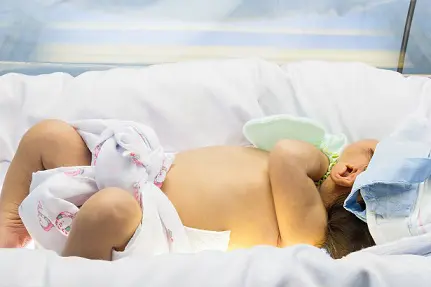What is Neonatal Jaundice?
Newborn jaundice or Neonatal Jaundice is a common and usually harmless condition in newborn babies that causes yellowing of the skin and the whites of the eyes.
Symptoms of newborn jaundice can also include a yellowing of the palms of the hands or soles of the feet, dark, yellow urine and pale stools.
Symptoms usually develop two to three days after birth and settle down by the time the baby is about two weeks old without treatment. This is known as physiologic jaundice
Diagnosis:
The level of bilirubin in the blood will be tested. This is done with a small device called a bilirubinometer, which beams light on to the baby’s skin and calculates the level of bilirubin.
A blood test for blood bilirubin levels is done on a sample of blood drawn from a heel prick. Blood tests are usually only necessary if your baby developed jaundice within 24 hours of birth or the reading is particularly high. Whether treatment is necessary or not will depend on the level of bilirubin in the baby’s blood.
Causes of newborn jaundice:
Jaundice is caused because of the increase in bilirubin levels in the blood. Bilirubin is produced by the breakdown of red blood cells in the blood. Newborn babies have a high level of red blood cells in their blood, which are gradually broken down and replaced. The bilirubin formed from this breakdown, travels in the blood to the liver. The liver processes the bilirubin by changing the form to one that can be passed out of the body in the stool.
Jaundice results if there is too much bilirubin in the blood or if the liver, because it is not fully developed in newborns, cannot get rid of it. By two weeks, the liver matures and is more effective in processing the bilirubin, so jaundice often corrects itself by this age.
Breastfeeding is sometimes associated with jaundice. How this happens is not clear but it is thought that breast milk contains substances that affects the liver’s ability to process bilirubin. However the benefits of breastfeeding far exceed the risks of jaundice and it is not necessary to stop breastfeeding because of this.
Sometimes, jaundice may be the result of other health conditions –this is called pathological jaundice.
- blood group incompatibility –If the mother and baby have different blood types
- Rh factor incompatibility: If the mother has Rh-negative blood and the baby has Rh positive blood
- a urinary tract infection
- Hypothyroidism
- Crigler-Najjar syndrome – an inherited condition that affects the enzyme responsible for processing bilirubin
- a blockage in the bile ducts and gallbladder can result in a buildup of bilirubin in the blood.
- G6PD deficiency could also lead to jaundice. This is associated with a family history of G6PD deficiency.
Treatment of Newborn jaundice:
Treatment is required only if the baby has high levels of bilirubin. If your baby’s jaundice doesn’t improve over time or tests show high levels of bilirubin in their blood, they may be admitted to hospital for treatment. Treatment is required to prevent the complication of kernicterus which can cause brain damage.
If treatment is needed, the bay should continue to be breastfed or bottle fed. Treatment of jaundice is with phototherapy. Phototherapy acts through a process called photo-oxidation in which oxygen is added to the bilirubin so that it dissolves in water and can be easily removed by the liver.
Phototherapy is given as
- conventional phototherapy in which the baby lies under a halogen or fluorescent lamp with their eyes covered
- fiberoptic phototherapy where the baby lies on a blanket with fiberoptic cables, through which light travels and shines on the baby’s back.
The bilirubin levels will be tested regularly after phototherapy has started. Phototherapy will be stopped when the bilirubin level falls to a safe level.
Phototherapy has very few side effects, except for a temporary rash or tan and is very effective in bringing down the bilirubin levels.
An exchange transfusion may be recommended if the levels of bilirubin are high or phototherapy hasn’t been effective. Small amounts of your baby’s blood are removed and then replaced with blood from a suitable matching donor. This serves to bring the levels of bilirubin down as the transfused blood has normal bilirubin levels.
If the jaundice is caused by Rh incompatibility (the mother has Rh negative blood and the baby has Rh positive blood), intravenous immunoglobulin (IVIG) may be used if phototherapy has not worked and the bilirubin levels are rising.



